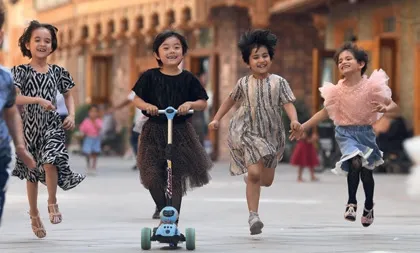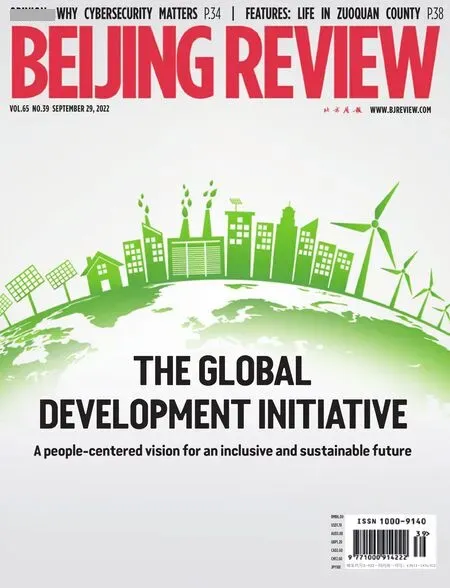Palpable Prosperity
By Muhammad Asghar
China’s Xinjiang Uygur Autonomous Region is renowned for its breathtaking natural beauty, wide-ranging ethnic customs, and abundant culture. It is China’s largest province-level region, covering an area of some 1.66 million square km—roughly the area of Iran. Home to 25.85 million people, the Han ethnic group accounts for 10.92 million and ethnic minorities for 14.93 million, according to data from the seventh national census in 2020.
As a reporter with the Associated Press of Pakistan (APP), I have traveled to several provinces and autonomous regions in China since 2013, and Xinjiang in particular after my appointment as special correspondent with the APP’s Beijing Office in 2017.During my visits to the region, I, along with other media workers, witnessed the region’s booming economic growth and infrastructure development, as well as the social and religious stability in major cities such as Urumqi, Kashgar, Hotan, Aksu and Turpan. People of all ethnic groups in Xinjiang live in harmony and enjoy full freedom of religious belief in accordance with the law.
According to local authorities,Xinjiang registered a 7-percent growth in GDP in 2021, totaling nearly 1.6 trillion yuan ($228 billion). The region created no less than 477,400 urban jobs during the same period, and an upward trend occurred in imports and exports as well as in the per-capita disposable income of urban and rural residents.
I hold some special memories of the friendly locals I met there,from all levels of society, all of whom are working hard to contribute to general development.During my last visit in April 2021, I traveled by air and land to Kashgar, Aksu, Turpan as well as the provincial capital of Urumqi,and everywhere I went, I saw people living in peace and harmony, gleaming with happiness and vitality. Over the past decade, cities across Xinjiang have undergone huge changes, and the old means of transport have all been replaced by a modern and robust transportation system which includes airplanes,railways, buses and cars. The prosperity is palpable.

Kids play on the street in Hotan, Xinjiang Uygur Autonomous Region
Freedom of religious belief
Xinjiang now features more than 24,000 mosques, meaning one mosque for every 530 Muslims on average. On September 26 last year, the State Council Information Office released a white paper titled Xinjiang Population Dynamics and Data, reiterating that “Xinjiang protects freedom of religious belief and ensures orderly practice of religion.Believers are free to engage in lawful religious activities, including worship, fasting,and observance of religious festivals, in accordance with religious doctrines, canons,and traditions, at religious venues or in their homes. They face no interference and restriction in this regard.”
According to Abdul Raqib, President of the China Islamic Association and head of the Xinjiang Islamic Institute in Urumqi,10 Islamic institutes have been established regionwide offering training to clergy in mosques to help them better perform their duties. People can access religious information through a range of channels, including state-authorized religious locations, periodicals and websites.
To improve the conditions of religious venues and their surrounding environment,the regional government has also made sure the mosques are all equipped with tap water,electricity, heating, air-conditioning, lavatories, communication tools, as well as libraries and even medical services.
I talked to Memet Juma, an imam of the 500-year-old Id Kah Mosque in Kashgar,during my visit in 2021. He told me that no restrictions are imposed on Muslims who want to observe fasting during the holy month of Ramadan.
Muslims in Kashgar and across the region are free to go to prayer at the mosques as the Constitution of China and Xinjiang’s regulations on religious affairs protect all normal religious practices.
However, the laws and regulations strictly forbid any activities disrupting public order,harming people’s health or obstructing the national education system under the guise of religion. From 1999 to late 2016, separatist and extremist forces launched numerous terrorist attacks by targeting government organs and staging riots throughout the region—greatly endangering public security. After years of relentless efforts, Xinjiang today has seen no violent terrorist attack in more than five consecutive years, with extremist intrusion effectively contained.
Truth be told
Back in January 2019, as a member of a foreign media delegation,I had the chance to visit the vocational education and training centers in Kashgar—an oasis city located on the ancient Silk Road linking China with the Western world, and Hotan—a bustling commercial center in south Xinjiang. Based on my firsthand experience, I found all allegations of “human rights abuse in Xinjiang” to be nothing but blatant lies.
I thought the so-called“camps,” as they are called in some Western media, would be places overflowing with people,encircled by barbed wire. But to my surprise, there was not a single guard standing at the entry gates or the centers. The facilities such as dormitories, cafeterias and sports fields, felt more like university campuses.
Inside these complexes,Uygur trainees were taking classes to learn standard Chinese pronunciation and skills such as housekeeping, sewing, painting and farming. They appeared confident, envisioning what they could and would do to build a better future with their own hands.
I still remember one trainee called Nurkamiljan at the Kashgar center. Prior to joining the training program, she had only received a primary-school education and was unemployed. Another female trainee wearing a colorful dress told me that she hoped to find a job with a decent salary after acquiring some useful skills at the center. During her period of studies, she usually traveled home to see her children on weekends. We were stunned to see some trainees singing and dancing in folk costumes, and their merry mood left us quite impressed.
We were later informed that all center trainees had either gone on to start up their own businesses or obtained jobs in Xinjiang,or other provinces in China, after finishing their training program.
During my last trip to Xinjiang, we also visited a cotton factory in Aksu, one of the country’s major fruit production centers, and the cotton fields near Urumqi, against the backdrop of allegations of “forced labor” in the agriculture sector.
The locals we interviewed held that the rights of workers there have been well protected under China’s laws and regulations.We did not detect any signs of forced labor.Moreover, the Chinese Government has ensured the mechanized sowing and harvesting of cotton crops in the region.
Anti-China forces, who intend to suppress the development of the cotton industry in Xinjiang with “forced labor” accusations,have actually denied locals their right to work and create a better life.
Based on my years of observation as an outsider, I believe people of all ethnic groups in Xinjiang understand that today’s regional prosperity, harmony and stability did not come easy. Ethnic equality and unity, religious harmony and socioeconomic prosperity are the common goals of all locals. In the end, the people of Xinjiang should have the final say over their own happiness. BR
- Beijing Review的其它文章
- En Route to Rebirth
- Setting the Table A village in north China offers its senior residents three free meals a day
- Road to Renewal Zuoquan County’s pursuit of self-development through promoting cooperatives and boosting industries
- SPACE WALK
- Structural Reform Progress
- Return and Revitalize Reviving tradition in China’s capital of porcelain

